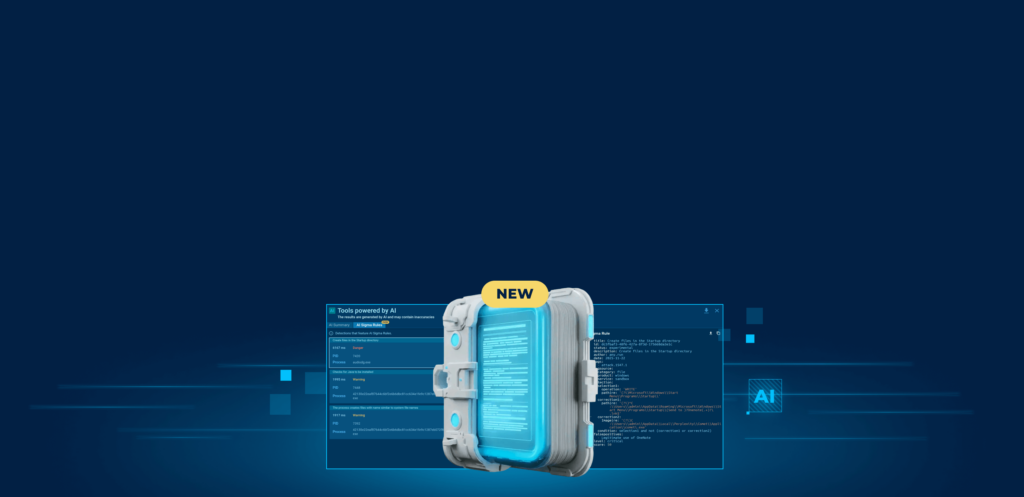In cybersecurity, a sandbox environment is a secure, isolated testing space where you can run and analyze software, including potentially malicious code, without risking harm to the main network or system.
Researchers run suspicious programs and URLs and watch out for if the code replicates itself, tries to contact a C2, drops additional payloads and so on. All in a controlled setting, separate from live production environments — like a jar for growing a viral culture in a laboratory.
What is the purpose of a sandbox?
Sandboxes, of course, aren’t just for cybersecurity — they’re also used for software development to test new code. In fact, that’s how sandboxes originally came to be.
Historically, the concept emerged as computing systems became more complex, necessitating safe testing areas to prevent widespread system failures. Technically, sandboxes can be implemented at different levels – from a simple virtual machine to a complex cloud-based environment, depending on the project’s needs.
In cybersecurity, sandboxes are crucial for analyzing malware. When a suspicious file is detected, it’s placed in the sandbox, an environment that mimics a real operating system but is completely isolated. This allows cybersecurity professionals to observe how the malware behaves, what system changes it attempts to make, and how it communicates with external servers. The technical sophistication here lies in making the sandbox environment realistic enough to trick the malware into activating, while also ensuring complete isolation to prevent any real system damage.
One interesting aspect of sandboxes in cybersecurity is their evolution. Early sandboxes were relatively simple and could be detected by sophisticated malware. Modern sandboxes like ANY.RUN interactive malware sandbox, however, have advanced to the point where they can closely mimic user behavior, network conditions, and even hardware responses, making them far more effective at tricking and analyzing advanced threats.
Application of sandboxes in cybersecurity
Sandboxes play an important role in network protection, forensic analysis, and incident response
- Network Protection: Sandboxes are useful for threat detection and prevention. Network traffic, including emails and file downloads, is routed through the sandbox for analysis. Here, any attached files or embedded links are opened in the sandbox to check for malicious behavior. Various operating systems and configurations are simulated, allowing a sandbox to detect malware designed for different environments.
- Forensic Analysis: Sandboxes are instrumental in understanding the behavior of malware post-infection. When a security breach is detected, the malware is captured and placed in the sandbox. Analysts then observe its behavior, such as file modification, network calls, and registry changes. This detailed analysis helps in identifying the malware’s capabilities, origin, and potential impact on the system.
- Incident Response: Here, sandboxes are used for containment and analysis. When an incident is detected, the suspect code is isolated in the sandbox. This allows incident responders to safely analyze the threat in real-time without risking further system compromise. They can test various countermeasures in the sandbox to see how the malware reacts, helping to develop an effective response strategy.
How does sandboxing work?
Depending on technical complexity, sandboxes can OS emulation or virtualization to create a controlled environment.
- In OS emulation, a sandbox precisely imitates an operating system to execute and analyze code. This involves replicating system responses, API calls, and hardware interactions, for example, by emulating the OS at the kernel level.
- Virtualization, in contrast, creates an entire virtual machine with its own OS, mimicking a full computing system. Hypervisors like VMware or Hyper-V can be employed for this purpose. These hypervisors can operate in two modes: Type 1 (bare-metal) directly on the system hardware, or Type 2 (hosted) running within the host OS. Each virtual machine functions independently, with its dedicated resources, ensuring isolation from the host system.
As the code runs, malware sandboxes employ monitoring to record its behavior. This involves logging system calls, changes to the file system, network activity, and even changes in the registry and RAM. Advanced monitoring techniques can include behavioral heuristics, which look for patterns typical of malicious activity, such as attempts to access certain system files or make unauthorized network connections.
Sophisticated malware often includes evasion techniques to detect a virtualized environment. For instance, it might check the presence of certain files, processes, or even hardware characteristics typical of virtual machines. To evade detection, malware might remain dormant or alter its behavior in a VM.
Interactive sandboxes in particular can counter this by allowing the analyst to make mouse movements and keystrokes, use a full-fledged browser for web interactions, and connect to the internet.
Sandbox examples
There are many different sandboxes with various intended use-cases. For example, ANY.RUN is designed specifically to analyze malware — you wouldn’t want to use it for personal tasks due to slight delays during use, a time limit for virtual machine sessions, and so on.
VirtualBox, on the other hand, is great if you want to run a virtual operating system within a host system, but you generally won’t use it for malware analysis (unless you’re manually reversing), because it lacks the detection and logging features of something like ANY.RUN.
With this in mind, here’s a list of sandbox examples:
- ANY.RUN: A cloud-based interactive sandbox where you can run, interact with, and analyze malware in a controlled environment.
- Windows Sandbox: Built into Windows 10 and later versions, it creates an isolated desktop environment designed to safely run untrusted software.
- HTML5 sandboxing: HTML5 has a built-in sandbox attribute used to enhance security in web browsers. It allows web developers to run untrusted HTML code in a restricted environment, limiting its access to the rest of the webpage and system.
- VirtualBox: A free and open-source hosted hypervisor for x86 virtualization, provided by Oracle. VirtualBox is widely used for creating and managing virtual machine environments.
Wrapping up
To summarize, a sandbox is a secure, isolated environment which uses OS emulation or virtualization to run software and malware. In cybersecurity, it serves as a controlled setting, like a lab jar where scientists can grow viruses without risking deadly outbreaks.
- Purpose of sandboxes: Originally developed for software testing, sandboxes have evolved into crucial tools for analyzing malware. They replicate a real operating system, allowing for safe observation of malware behavior.
- Applications of sandboxes in cybersecurity: Sandboxes analyze network traffic for threat detection and prevention, help understand malware’s behavior post-infection and are used for safe containment and analysis of threats during incidents.
About ANY.RUN
ANY.RUN is a cloud malware sandbox that handles the heavy lifting of malware analysis for SOC and DFIR teams. Every day, 300,000 professionals use our platform to investigate incidents and streamline threat analysis.
Request a demo today and enjoy 14 days of free access to our Enterprise plan.








0 comments